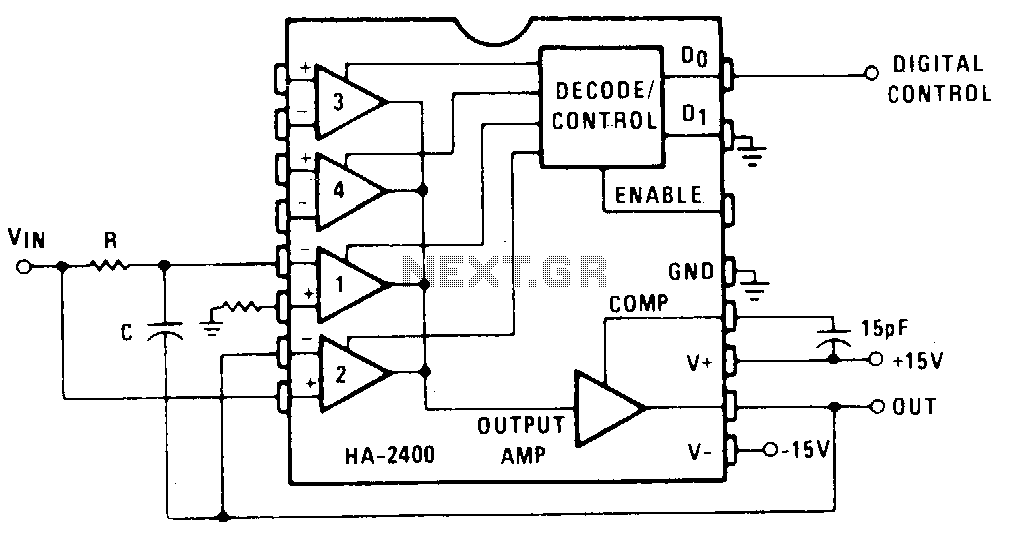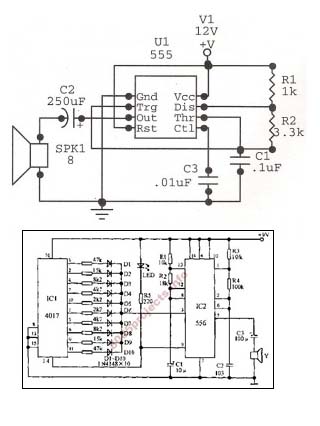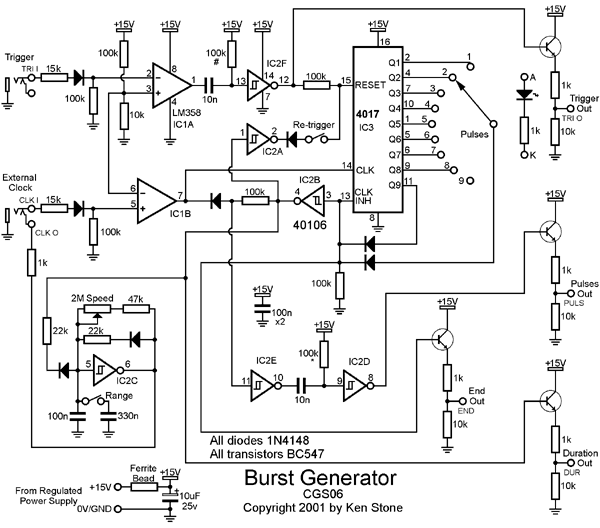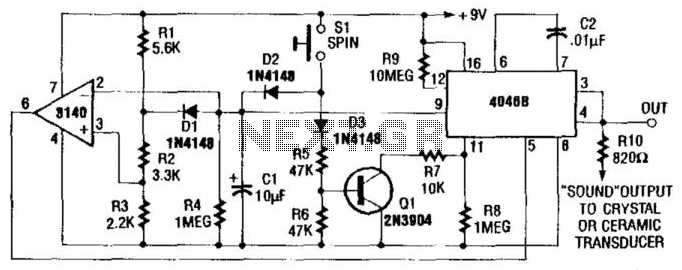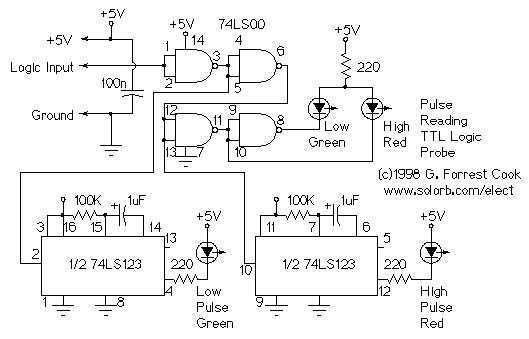
Long-Interval Pulse Generator
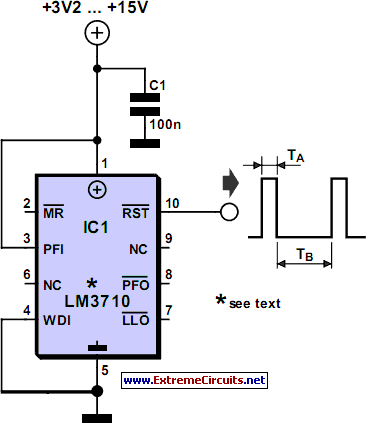
A rectangular-wave pulse generator with an extremely long period can be constructed using only two components: a National Semiconductor LM3710 supervisor integrated circuit (IC) and a 100-nF capacitor to suppress noise spikes. This circuit leverages the watchdog and reset timers integrated within the LM3710. The watchdog timer is reset when an edge signal is detected on the WDI input (pin 4). If the WDI input remains continuously at ground level, no edges are detected, causing the watchdog timer to time out. After a specific interval, TB, a reset pulse is triggered with a duration of TA, and the timer is reloaded with its initial value. The cycle then repeats. Consequently, rectangular pulses with a period of TA + TB appear at the RESET output (pin 10). Periods of up to approximately 30 seconds can be achieved using this method. The intervals TA and TB are dictated by internal timers within the IC, which is available in various versions, each offering four different timer ranges. To achieve the desired pulse period, it is essential to select the appropriate version of the LM3710. The type designation can be decoded from the accompanying table. The reset threshold voltage is not relevant for this application of the LM3710. The versions highlighted in bold were available at the time of publication. Current information can be found on the manufacturer's website. The numbers in brackets indicate the minimum and maximum values of intervals TA and TB for which the LM3710 has been tested. The circuit operates with a supply voltage ranging from 3 to 5 V.
The rectangular-wave pulse generator circuit described utilizes the LM3710 supervisor IC, which is designed for monitoring power supply voltages and providing supervisory functions. In this application, the LM3710's watchdog timer is employed to create a periodic pulse output. The circuit is straightforward, consisting of the LM3710 and a 100-nF capacitor that serves to filter out noise, ensuring stable operation.
The WDI input (pin 4) of the LM3710 is critical for the operation of the watchdog timer. When an edge transition occurs on this pin, the watchdog timer resets, preventing it from timing out. If the WDI pin is held low (grounded), the watchdog timer will time out after the interval TB. This timeout event generates a reset pulse at the RESET output (pin 10) with a duration specified by TA. After the reset pulse, the internal timer is reloaded, and the cycle begins anew, producing a continuous output of rectangular pulses with a period of TA + TB.
The design allows for flexibility in the pulse period, with the LM3710 being available in different versions that cater to various timer ranges. By selecting the appropriate version, the desired intervals TA and TB can be achieved, thus tailoring the pulse generator's output to specific application requirements. The reset threshold voltage is not a concern for this implementation, as the primary function is to generate long-period rectangular pulses.
For practical implementation, it is essential to refer to the manufacturer's documentation to decode the type designation of the LM3710 and ensure that the chosen version meets the necessary specifications. The circuit is designed to operate within a supply voltage range of 3 to 5 V, making it suitable for a variety of low-power applications. Overall, this simple yet effective circuit provides a reliable solution for generating long-period rectangular-wave pulses with minimal component requirements.A rectangular-wave pulse generator with an extremely long period can be built using only two components: a National Semiconductor LM3710 supervisor IC and a 100-nF capacitor to eliminate noise spikes. This circuit utilises the watchdog and reset timers in the LM3710. The watchdog timer is reset when an edge appears on the WDI input (pin 4). If WDI is continuously held at ground level, there are not any edges and the watchdog times out. After an interval TB, it triggers a reset pulse with a duration TA and is reloaded with its initial value. The cycle then starts all over again. As a result, pulses with a period of TA + TB are present at the RESET output (pin 10). As can be seen from the table, periods ranging up to around 30 seconds can be achieved in this manner.
The two intervals TA and TB are determined by internal timers in the IC, which is available in various versions with four different ranges for each timer. To obtain the desired period, you must order the appropriate version of the LM3710. The type designation is decoded in the accompanying table. The reset threshold voltage is irrelevant for this particular application of the LM3710. The versions shown in bold face were available at the time of printing. Current information can be found on the manufacturer`s home page ( The numbers in brackets indicate the minimum and maximum values of intervals TA and TB for which the LM3710 is tested.
The circuit operates with a supply voltage in the range of 3 5 V. 🔗 External reference
The rectangular-wave pulse generator circuit described utilizes the LM3710 supervisor IC, which is designed for monitoring power supply voltages and providing supervisory functions. In this application, the LM3710's watchdog timer is employed to create a periodic pulse output. The circuit is straightforward, consisting of the LM3710 and a 100-nF capacitor that serves to filter out noise, ensuring stable operation.
The WDI input (pin 4) of the LM3710 is critical for the operation of the watchdog timer. When an edge transition occurs on this pin, the watchdog timer resets, preventing it from timing out. If the WDI pin is held low (grounded), the watchdog timer will time out after the interval TB. This timeout event generates a reset pulse at the RESET output (pin 10) with a duration specified by TA. After the reset pulse, the internal timer is reloaded, and the cycle begins anew, producing a continuous output of rectangular pulses with a period of TA + TB.
The design allows for flexibility in the pulse period, with the LM3710 being available in different versions that cater to various timer ranges. By selecting the appropriate version, the desired intervals TA and TB can be achieved, thus tailoring the pulse generator's output to specific application requirements. The reset threshold voltage is not a concern for this implementation, as the primary function is to generate long-period rectangular pulses.
For practical implementation, it is essential to refer to the manufacturer's documentation to decode the type designation of the LM3710 and ensure that the chosen version meets the necessary specifications. The circuit is designed to operate within a supply voltage range of 3 to 5 V, making it suitable for a variety of low-power applications. Overall, this simple yet effective circuit provides a reliable solution for generating long-period rectangular-wave pulses with minimal component requirements.A rectangular-wave pulse generator with an extremely long period can be built using only two components: a National Semiconductor LM3710 supervisor IC and a 100-nF capacitor to eliminate noise spikes. This circuit utilises the watchdog and reset timers in the LM3710. The watchdog timer is reset when an edge appears on the WDI input (pin 4). If WDI is continuously held at ground level, there are not any edges and the watchdog times out. After an interval TB, it triggers a reset pulse with a duration TA and is reloaded with its initial value. The cycle then starts all over again. As a result, pulses with a period of TA + TB are present at the RESET output (pin 10). As can be seen from the table, periods ranging up to around 30 seconds can be achieved in this manner.
The two intervals TA and TB are determined by internal timers in the IC, which is available in various versions with four different ranges for each timer. To obtain the desired period, you must order the appropriate version of the LM3710. The type designation is decoded in the accompanying table. The reset threshold voltage is irrelevant for this particular application of the LM3710. The versions shown in bold face were available at the time of printing. Current information can be found on the manufacturer`s home page ( The numbers in brackets indicate the minimum and maximum values of intervals TA and TB for which the LM3710 is tested.
The circuit operates with a supply voltage in the range of 3 5 V. 🔗 External reference
